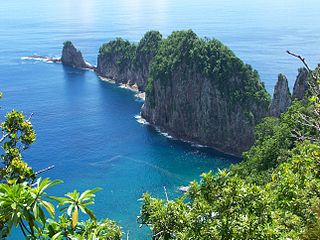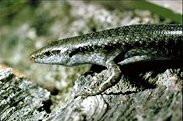
The National Park of American Samoa is a national park of the United States located in the territory of American Samoa, distributed across four islands: Tutuila, Ofu, Olosega, and Ta‘ū. The park preserves and protects coral reefs, tropical rainforests, fruit bats, and the Samoan culture. Popular activities include hiking and snorkeling. Of the park's 8,257 acres (3,341 ha), 2,500 acres (1,000 ha) is coral reefs and ocean. The park is the only American National Park Service system unit south of the equator.
The Samoan white-eye is a species of bird in the family Zosteropidae. It is endemic to the island of Savai'i in Samoa.

The Temotu flying fox is a species of flying fox in the family Pteropodidae. It is endemic to the Solomon Islands. It is threatened by habitat destruction due to subsistence agricultural practices, as well as natural disasters such as tropical cyclones. Due to its imperiled status, it is identified by the Alliance for Zero Extinction as a species in danger of imminent extinction. In 2013, Bat Conservation International listed this species as one of the 35 species of its worldwide priority list of conservation.

The Samoa flying fox or Samoan flying fox is a species of flying fox in the family Pteropodidae. It is found in American Samoa, Fiji, and Samoa. Its natural habitat is subtropical or tropical dry forests.

The mao or ma'oma'o is a passerine bird belonging to the genus Gymnomyza in the honeyeater family Meliphagidae. It is an endangered species and is endemic to the Samoan Islands.

Aglaia samoensis is a species of tree in the family Meliaceae. It is found in American Samoa, New Guinea, Samoa, the Solomon Islands, Vanuatu, and Wallis and Futuna Islands.
Balaka insularis is a rare species of flowering plant in the palm family endemic to Samoa. It was formerly placed in the monotypic genus Solfia with the species name Solfia samoensis. It was placed in the genus Balaka in 2014.

Emoia adspersa, Steindachner's emo skink, the Micronesian skink, dark-sided emoia, dark-sided skink, or dateline emoia, is a species of lizard in the family Scincidae. It is found in Micronesia. The species has also been noted to occur on Niuafoʻou, the northernmost island of Tonga, with sightings in 1930 and 1994. The species is not present on other Tongan islands, and is possibly present due to waif dispersal occurring during Polynesian migration.

Emoia boettgeri, also known commonly as Boettger's emo skink, the Micronesia forest skink, and the Micronesia spotted skink, is a species of lizard in the family Scincidae. The species is native to Micronesia. There are no recognized subspecies.
Emoia campbelli, also known commonly as Campbell's skink, the montane emo skink, and the Vitilevu mountain treeskink, is a species of lizard in the family Scincidae. The species is endemic to the island of Viti Levu in Fiji.
The common emo skink or Erronan treeskink is a species of lizard in the family Scincidae. It is found Futuna Island in Vanuatu.

Emoia lawesii, also commonly known as Günther's emo skink and the olive small-scaled skink, is a species of lizard in the subfamily Eugongylinae of the family Scincidae. The species is native to Polynesia.
Emoia mivarti, Boulenger's emo skink or the Admiralty five-striped skink, is a species of lizard in the family Scincidae. It is found in the Admiralty Islands and Indonesia.

Emoia nigra, the black emo skink, is a species of lizard in the family Scincidae. It is found from the Solomon Islands, Vanuatu, eastward through Fiji to Tonga, Samoa, Toga, Lo, Tegua, and Hiu Island.

Emoia slevini, also known commonly as the Mariana skink, Slevin's brown skink, Slevin's emo skink, and Slevin's skink, is a species of lizard in the family Scincidae. The species is endemic to the Mariana Islands.
The Polynesia slender treeskink is a species of lizard in the family Scincidae. It is found in western Samoa and some northern Tongan islands.
Emoia trossula, also known commonly as the Fiji barred treeskink, Gibbons's emo skink, and the Viti barred treeskink, is a species of lizard in the family Scincidae. The species is native to archipelagos in the tropical Pacific Ocean.












